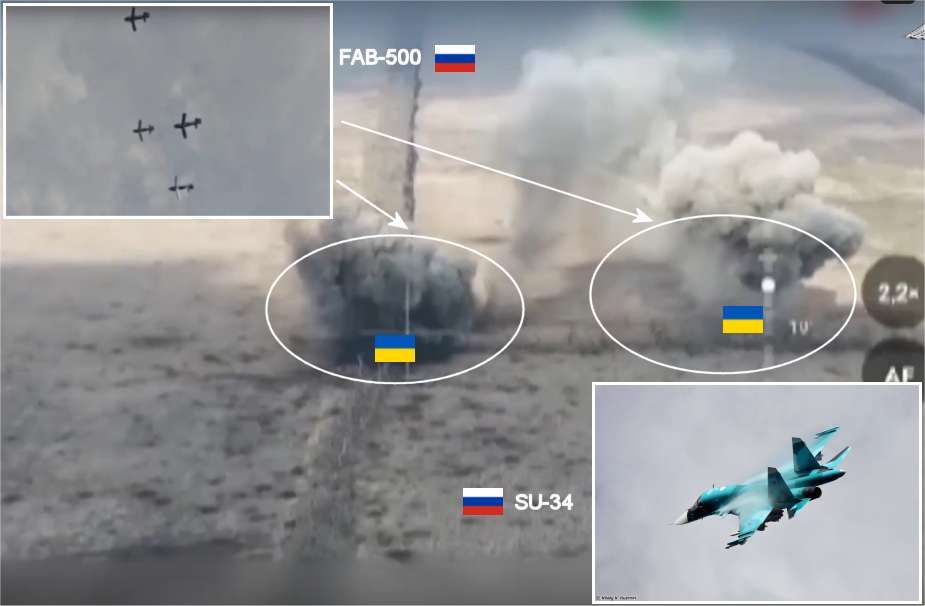- Army
- Conflicts in the world
- Israel - Iran conflict 2025
- Pakistan - India Conflict 2025
- Russia Ukraine War 2022
- Libya conflict day by day
- HAMAS - Israel War 2023
- Operation Serval in Mali French Army
- Sangaris operation Central African Republic
- Sangaris opération militaire République Centreafrique
- Ukraine - Russia conflict
- Syria conflict news
- Defence & Security Industry Technology
- Armies in the world
- Analysis Defense and Security Industry
- Conflicts in the world
- Navy
- Air
Russian Su-34 strikes Ukrainian forces with new guided bomb FAB-500
The Russian Ministry of Defense recently highlighted, in an official statement, a successful operation conducted by Su-34 aircraft in the Avdeevka sector in Ukraine, employing FAB-500 bombs enhanced with a universal planning and correction module for precise targeting. This operation emphasizes the crucial role of the Su-34 in Russia's military strategy, capable of conducting strikes from safe distances, beyond Ukrainian air defenses.
Follow Army Recognition on Google News at this link

Russia unveils a successful operation conducted by Su-34 aircraft in the Avdeevka sector in Ukraine. (Picture source: Vitaly Kuzmin / Russian MoD)
Ukrainian forces have achieved success against Russian military aircraft. Within the last two weeks, Ukraine reported the downing of 13 Russian warplanes, marking one of the highest losses for the Russian Air Force since the early days of the conflict. The aircraft destroyed include 10 Su-34 fighter bombers, two Su-35 fighter jets, and a rare A-50 military spy plane, with another A-50 having been downed a month earlier. The loss of three Su-34s occurred on a single day over eastern Ukraine, highlighting the effectiveness of Ukraine's air defense capabilities.
Despite Ukraine's success in destroying a large number of Russian aircraft in recent weeks, which represents a considerable feat, Russia still possesses a massive and vastly superior aerial arsenal compared to the Ukrainian air force and is still capable of carrying out successful operations like the one highlighted by the Russian Ministry of Defense.
The Sukhoi Su-34, known by the NATO reporting name "Fullback," is a Russian two-seat combat aircraft designed for high-precision strikes against ground and aerial targets, even under dense enemy defense. A derivative of the Su-27 Flanker family, the Su-34 stands out with its unique design tailored for long-duration missions, offering a spacious cockpit equipped for the crew's comfort, including an in-flight galley and lavatory.
Technically, the Su-34 showcases impressive specifications: a maximum speed of 1,900 km/h at high altitude and 1,300 km/h at low altitude, with a service ceiling of 14,000 meters. Its operational range is significant, capable of conducting missions up to 4,000 km, extendable with external fuel tanks. Its comprehensive armament includes a 30mm GSh-301 cannon, a variety of missiles (air-to-air, air-to-surface, anti-ship), and precision-guided bombs, making it versatile across different combat scenarios.
Initially developed in the 1990s, the Su-34 entered service with the Russian Air Force in 2014, after a series of updates and testing phases that highlighted its potential as a multifunctional combat aircraft. Since then, it has been actively integrated into Russian military operations, demonstrating its strategic importance.
The Su-34's incorporation of advanced avionics, including a phased array radar for enhanced situational awareness, an electronic countermeasures suite, and a rearward-looking radar to detect approaching threats, exemplifies modern military aviation technology. The cockpit design, facilitating a two-person crew, improves operational efficiency through workload sharing and increased situational awareness.
This recent operation in the Avdeevka sector not only illustrates the Su-34's operational capabilities but also reflects that Russia still has the means to strike Ukrainian positions using its aviation, even if it has been recently challenged by Ukrainian victories.


























